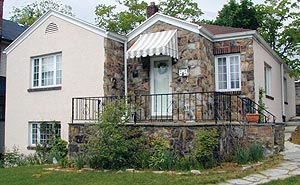
…continued from previous page
Masonry & Stucco Surfaces
When prepping masonry and stucco surfaces for sealing, experts say contractors must remember the fundamentals: know the substrate you're dealing with, the look you want to achieve, and the pros and cons of the various products on the market.
by Christina Camara
The basic types of sealers available today are the clear, penetrating coatings; pigmented coatings; and film-forming products, all of which come in both water- and oil-based formulations.
Roemheld says the clear, penetrating sealers can deepen or enrich the color of the stone or masonry, “but in most cases, you don’t even know they’re there.”
Neary of UGL says most clear masonry coatings are water sealers, which repel water, not waterproofers, which hold back water even under pressure. Water sealers protect against water entering the substrate, but are breathable and allow water vapors to escape.
The pigmented coatings can be water sealers or waterproofers. It’s possible to turn your masonry a different color while waterproofing it at the same time. Film-forming products do just what the name implies. “These typically give you a shiny film if you want, so your masonry looks like a candy apple,” Roemheld says.
Contractors who don’t know about the range of products available should develop a good relationship with a supplier who does, Welsh says. Even so, read the fine print. Some products that are sold for exterior patching should be applied in a thin film — and it says so on the can — but some contractors incorrectly use it like putty, stuffing it into deep cracks, he says.
Mike Kozlowski, senior product manager, Thompson’s Water Seal brand, agrees that knowing the specific capabilities of various products is important. Make sure the products are guaranteed to prevent water damage, as not all products that claim to waterproof exterior surfaces work as promised, he says.
A few tips:
If you find spalling, make sure to use a water-repellent sealer that has binding capabilities to hold it all together and keep water out of the fissures.
Neary believes acrylic products are best because the formulations allow tiny moisture vapors to escape but the molecules are so tight that rain cannot penetrate the surface. “Stucco and masonry are porous substrates, it is important for them to breathe so moisture does not get trapped and cause the building to deteriorate or the coatings to bubble or peel.”
Determine if etching is needed. Smooth concrete may need etching to open the surface and allow the waterproofer to penetrate, Kozlowski says. Broom-swept concrete or concrete with a minimum texture of 80-grit sandpaper does not need etching.
Do not use regular house paints on masonry. “Ordinary house paint goes on thick and hides the natural beauty of the masonry surface,” Neary says, “while a paint that is specifically formulated for masonry will go on thin to accentuate the texture.”
Application notes
Before any sealers can be applied to masonry or stucco, the surface must be completely clean and dry. Mildew, dirt and old flaky or peeling coatings must be removed. If it’s not clean, “you might as well go to the beach and paint sand — that’s about as long as it will last,” Welsh says.
Kozlowski of Thompson’s says to consider weather conditions when applying sealers. Most waterproofers need to be applied to a thoroughly dry surface (although Thompson’s Water Seal Concrete Care Sealer can be applied to slightly damp surfaces), and when rain is not forecast in the near future. Also, both water-based and traditional sealers usually need to be applied at temperatures of about 40 - 50 degrees.
One of the drawbacks of using acrylic products is that the surface can turn milky white if the coating is applied too heavily and is not brushed out thoroughly, Roemheld says. A too-thick coat that doesn’t cure properly can trap moisture, just as a coffee table will show a ring when a sweaty glass is placed on it.
Experts also have advice for sealing green surfaces: Don’t rush. The surface must be properly cured. Normally, it takes 28 to 30 days for concrete-based products (or up to 45 days in some cases).
ABR’s Roemheld says that once the stucco or masonry is sealed, cleaning will be a lot easier. The surface should continue to be maintained with the right tools and the right products. “Easy does it,” he says. “Start with the simple stuff first.” Start with biodegradable cleaners and soft brushes, then try something a little stronger, such as an acetic acid solution. Using caustic cleaners or too much water pressure on these porous surfaces can remove the sealers or chip away at the substrate itself. “If you’re cleaning stucco, acids are probably a no-no,” he says. “You’d actually wash the stucco away.”
hink about the environment too. “Bleach is corrosive,” he says. “It’s not good for the environment and it’s not good for the user.”
Restoring and preserving: that’s the goal contractors are aiming for when they inspect masonry or stucco, evaluate the problems, fix them and pick the best sealer for the job.

|

